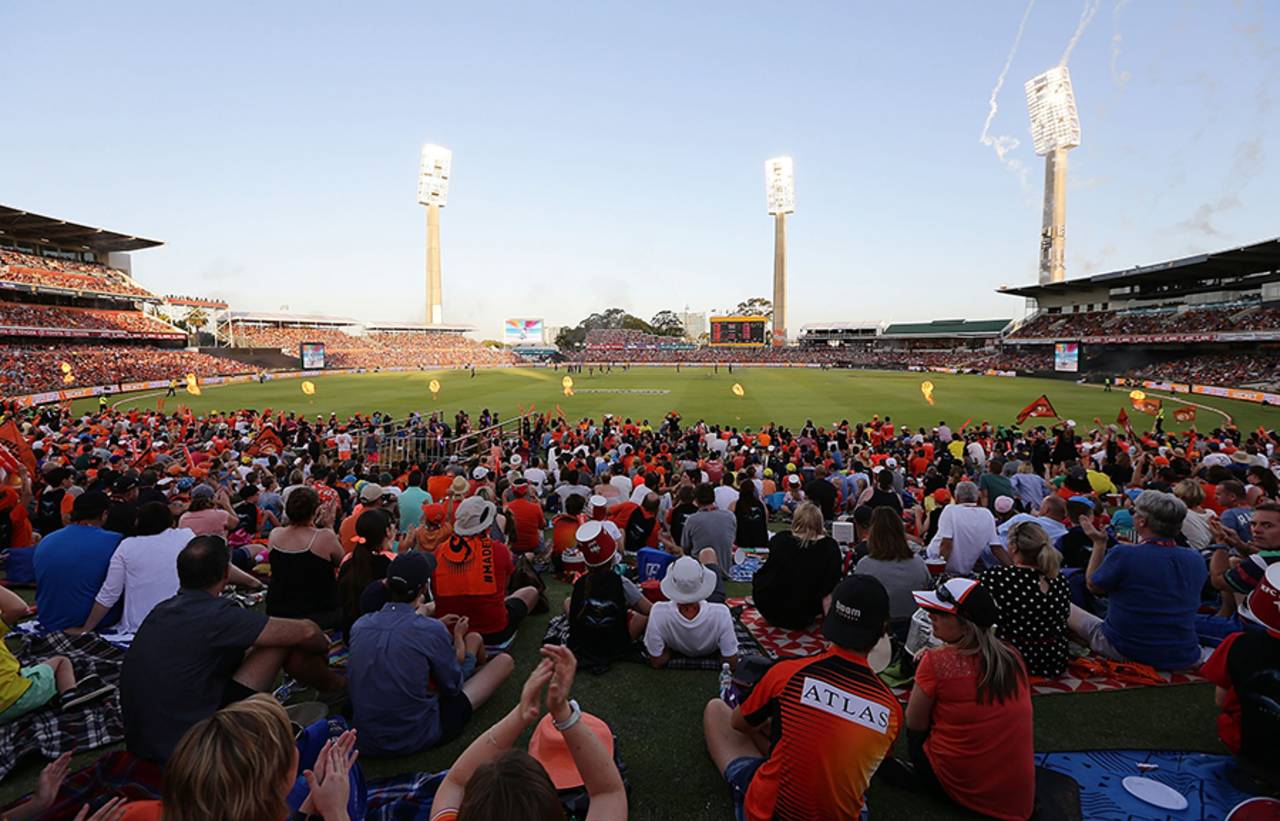Cricket stretches Australian footprint
As cricket's footprint on the Australian summer grows in unprecedented fashion, the Cricket Australia's chief executive James Sutherland insists that the burgeoning Big Bash League is acting as a complementary, not competing, agent to the traditional Test
Daniel Brettig
03-Jan-2016

The record BBL crowd at the MCG on Saturday was complemented by another sellout gathering at the WACA ground • Cricket Australia/Getty Images
As cricket's footprint on the Australian summer grows in unprecedented fashion, Cricket Australia's chief executive James Sutherland insists that the burgeoning Big Bash League is acting as a complementary, not competing, agent to the traditional Test summer.
A staggering crowd of 80,883 at the MCG for the Melbourne BBL derby on Saturday night was followed up by another record gathering at the WACA Ground. A strong SCG crowd of 32,086 for day one of the New Year's Test between Australia and the West Indies - despite indifferent weather - will be followed up by a gathering in the region of 25,000 for another BBL fixture at the Gabba, meaning more than 150,000 spectators will have watched the game over two days across four cities.
When combined with uniformly strong television audiences, including a groundbreaking 372,000 average for the curtain-raising WBBL match at the MCG ahead of the Stars' BBL defeat of the Renegades, the game's hold over the first week of 2016 in Australia is complete. Talk of the MCG crowd as transformational is understandable, but it should also be combined with concurrent attendances in other parts of the country.
While it has been suggested more than once that the BBL is detracting from Tests, Sutherland told ESPNcricinfo that the tournament was always intended to complement the five-day game - and that it had given CA the ability to draw crowds across the country in ways previously unheard of during the international programme.
"One of the things that people forget from time to time is the thing the BBL has allowed us to do, [it has] allowed us to provide cricket content in other parts of Australia during the Test cricket season," Sutherland said. "Right now we're playing in other parts of the country and people are watching the cricket during the day [on TV] then saying 'Let's go and watch a Big Bash League game'.
"One of the unusual things about Test cricket is it's the premium format but it goes for a week and your best players can't be playing anywhere else but where they are. We're such a big country, it's not as if people from Brisbane can just easily turn up to a Boxing Day or New Year's Test match, but we can give them quality cricket content to supplement what they're seeing on TV, and I think that's one of the great benefits in a complementary sense about the way the BBL is working."
The contrast with the previous instance in which the struggling West Indies team were a part of the summer Test schedule is stark. In 2009-10, international matches were watched by the poorest crowds and slimmest television audiences in some years, and CA ran at a considerable loss for the season, cutting into cash reserves.
A sense of stagnation hung over CA at the time, fuelling the advent of the Australian Cricket Conference, which was the catalyst for numerous reforms including the BBL and long overdue changes to CA's governance. Though the Caribbean side have deteriorated since that visit, Australian cricket no longer relies exclusively upon international matches to maintain interest and balance the books, and in many ways can now build a wider audience than previously. Sutherland spoke of a "symbiotic" relationship between T20, Tests and ODIs down under where the game benefits overall.
"There's no doubt the BBL is on a trend line upwards in terms of its popularity and part of that is an awareness thing," Sutherland said. "I think there's a growing awareness and a growing allegiance to teams and the whole concept of the BBL, which is pleasing. Clearly we're targeting certain markets for growth and bringing new people to the game and it's so far been successful in doing that.
"How you then overlay that increase with the natural ups and downs you get from our four-year cycle of international cricket, which has been going for 40 years ... we have always got bigger crowds to Ashes matches. At the moment India is probably the second biggest drawing country, and South Africa has been strong as well. But if you go back 20 or so years, it was West Indies who were the big drawcard behind an Ashes series, so there's that natural fluctuation.
"We haven't done a major review of this season just yet, we're right in the middle of it, but it's all positive and I think we'll find to some extent they're working together. Our aim is to have them working in a complementary fashion and to have some sort of symbiotic relationship between the three formats of the game that keep the game on the radar in a positive sense."
As for the crowds and broadcast audience numbers generated over the past 48 hours, Sutherland was understandably chuffed. "To have more than 100,000 people attend Big Bash League matches on the same day was a great occasion for our sport and a genuine milestone in the short history of the league," he said. "And of course, these crowds were complemented by big TV numbers of more than a million viewers.
"Although the Big Bash League is continuing to develop, it is successfully delivering on its purpose to attract kids, families and females to cricket. We took as much delight from the WBBL results. Almost 13,000 people came to watch the local derby at the MCG, with the TV audience peaking at more than 400,000 viewers on Ten's main channel. It just goes to show the potential for women's cricket in Australia."
Daniel Brettig is an assistant editor at ESPNcricinfo. @danbrettig